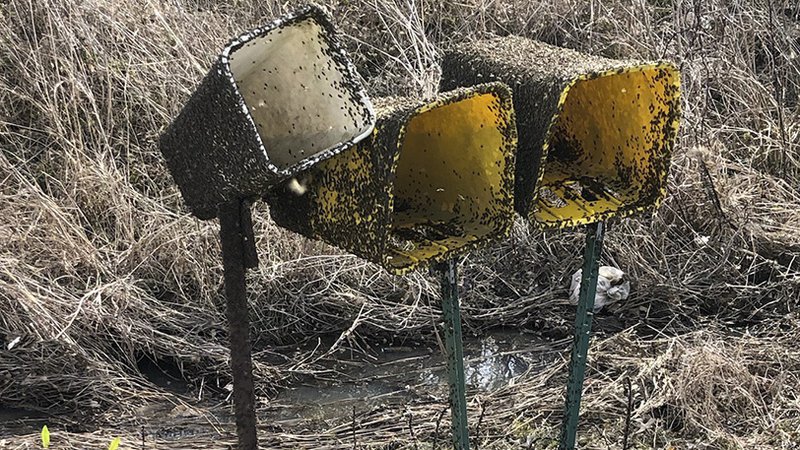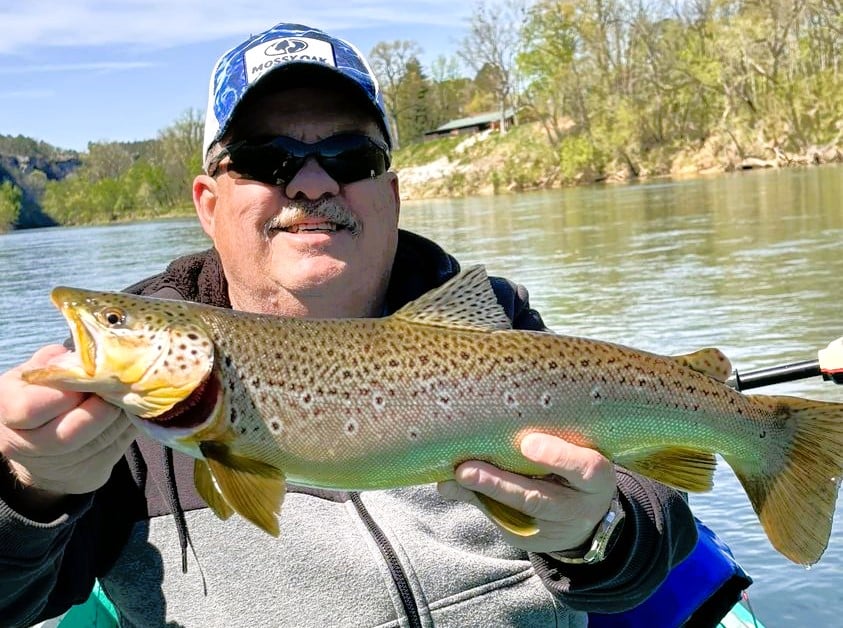Flooding, weather create conditions for another buffalo gnat outbreak in Arkansas
ON 03-20-2019

March 20, 2019
Randy Zellers
Assistant Chief of Communications
LITTLE ROCK – As floodwaters recede in southern and eastern Arkansas, many residents have already reported alarming numbers of buffalo gnats covering mailboxes, harassing pets and livestock, and chasing spring turkey hunters with no head nets out of the bottomland hardwoods. Reports from county extension agents have indicated that buffalo gnats are much worse than normal, rivaling preliminary estimates from last year’s huge outbreak of the insects.
According to the University of Arkansas Division of Agriculture, roughly 100 domesticated animals and at least 280 deer were killed during the buffalo gnat outbreak that occurred last March. While the outbreak did not pose a threat to wildlife on a population level, they did cause concern among many people who saw photos and videos of animals plagued by insects and caused an extreme nuisance for many outdoors enthusiasts and people working outdoors in areas affected by the swarms.
Southern buffalo gnats, a type of black fly, are common in Arkansas, but rarely pose a problem unless the conditions line up to create a large hatch. They breed in moving water and their eggs can be found in the silt. Flooded areas with flowing water can hatch large quantities of eggs, and if the water temperature is mild, the eggs will hatch in a very short period. The March through May period tends to have the most favorable conditions for this sort of hatch until the weather becomes dry and hot enough to suppress the insects’ life cycles.
Kelly Loftin, Ph.D., extension entomologist for the University of Arkansas’s Division of Agriculture, says swarms of these biting flies can on rare occasions kill some animals.
“The animals can die from blood loss and even suffocating because their airway is compromised, but the most common cause of death comes from shock,” Loftin said. “The anti-coagulant in the fly’s saliva can accumulate when thousands are biting an animal, causing them to die from toxic shock similar to allergic reactions.”
Loftin says the reports so far are not quite as intense as last year, but the peak of last year’s outbreak was around April 1, which is still weeks away.
“The wind also can be helping us because buffalo gnats are not particularly strong fliers and strong winds can prevent them from feeding,” Loftin said. “The wind is forecast to die down next week, so we should see how bad it will be very soon.”
Loftin says the buffalo gnats hatching now may not have even come from eggs that were laid this year.
“The flies lay their eggs in flowing water, and the eggs sink into the silt,” Loftin said. “They can be dormant in that soil for years until another flood hits when temperatures are conducive to hatching. This huge increase in breeding area is why the gnats were so bad last year and could be bad again.”
Loftin says there isn’t anything that can really be done on a large scale to prevent such outbreaks, but temperature changes can be beneficial.
“When the water is in the 50s and low 60s, the eggs hatch and larvae have good growth rates. But once you get water temperature in the high 60s, the eggs won’t hatch as well and the life cycle of the insect is slowed.”
Some landowners hoping to protect domestic cattle, horses and other livestock have been known to burn stacks of hay and straw to create smoke, which can give animals temporary relief from the swarms of biting insects. Many will report deer and other wildlife coming close to the smoke to catch a break from the bugs as well.
“The smoke helps repel the insects, and you’ll see cows and deer herd up in the plumes of smoke produced by the hay,” Loftin said. “Old, wet hay tends to produce a lot of smoke once it gets going and smolders. But hay can be in short supply regionally.”
Jeremy Brown, assistant deer program coordinator with the Arkansas Game and Fish Commission, says burning hay can be beneficial for landowners on a small scale, but is not an option for large-scale populations such as white-tailed deer.
“Unfortunately this won’t help most of the wildlife and isn’t an option on most public land,” Brown said. “Most of the area impacted is either privately held or is on the (Dale Bumpers) White River National Wildlife Refuge. With the vast amount of land, we don’t have the manpower to monitor and maintain burning hay bales throughout the bottoms.”
Brown also has been approached with questions on why the AGFC or other agencies could not spray the bugs with crop dusters, but that method also is ineffective at controlling insect outbreaks and can cause more harm than good.
“Mass spraying of insecticide from a crop duster could potentially have negative impacts on other wildlife relying on insects as a food source,” Brown said. “You would have to get the treatment through the trees as well.”
As trees begin to sprout leaves, the shaded bottomland hardwoods in the floodplains where many of these insects hatch will be protected from aerial applications by the forest canopy. The insects’ incredibly fast life cycles also hinder any sort of lasting measure of prevention.
Brown says even if such treatments were possible, they would only be temporary relief from the issue.
“Buffalo gnats can have multiple hatches during spring depending on environmental conditions, so more gnats would continue to hatch as long as the environment was right,” Brown said. “Water treatment chemicals can be used in some small scale local instances, but the water where the vast majority of these gnats is coming from is the White River and its tributaries, which are too large and swift to treat with such chemicals.”
Brown says the best thing biologists can do is monitor the outbreak and determine any lasting impacts. Anyone who witnesses a deer death from the gnats is encouraged to report it to Brown at 870-275-5245 or by email at agfc.health@agfc.ar.gov. Report any livestock losses to the UA Cooperative Extension Service at 870-946-3231. When reporting deer deaths please provide the witnesses name, phone number, county, number of dead animals and GPS coordinates to the location of the dead deer (if possible).
Recent News

Arkansas Wildlife Weekly Fishing Report
Apr. 18, 2024
Subscribe to Our Weekly Newsletter E-mails
Don’t miss another issue. Sign up now to receive the AGFC Wildlife Weekly Newsletter in your mailbox every Wednesday afternoon (Waterfowl Reports are published weekly during waterfowl season and periodically outside the season). Fishing Reports arrive on Thursdays. Fill in the following fields and hit submit. Thanks, and welcome!

